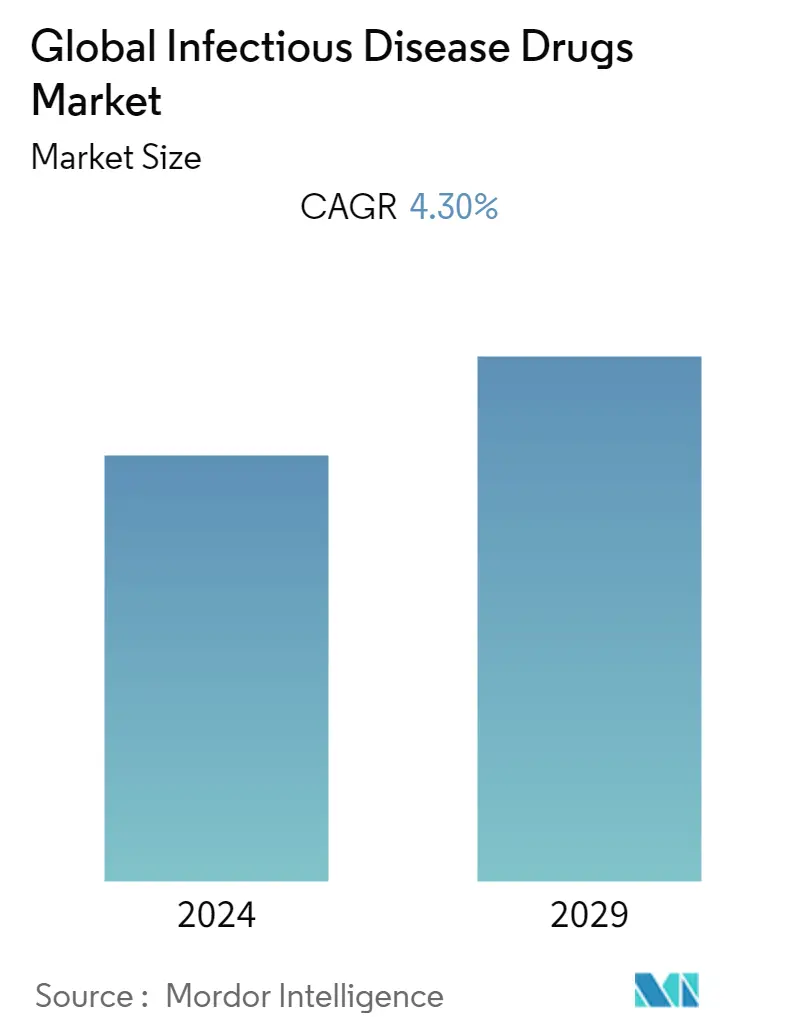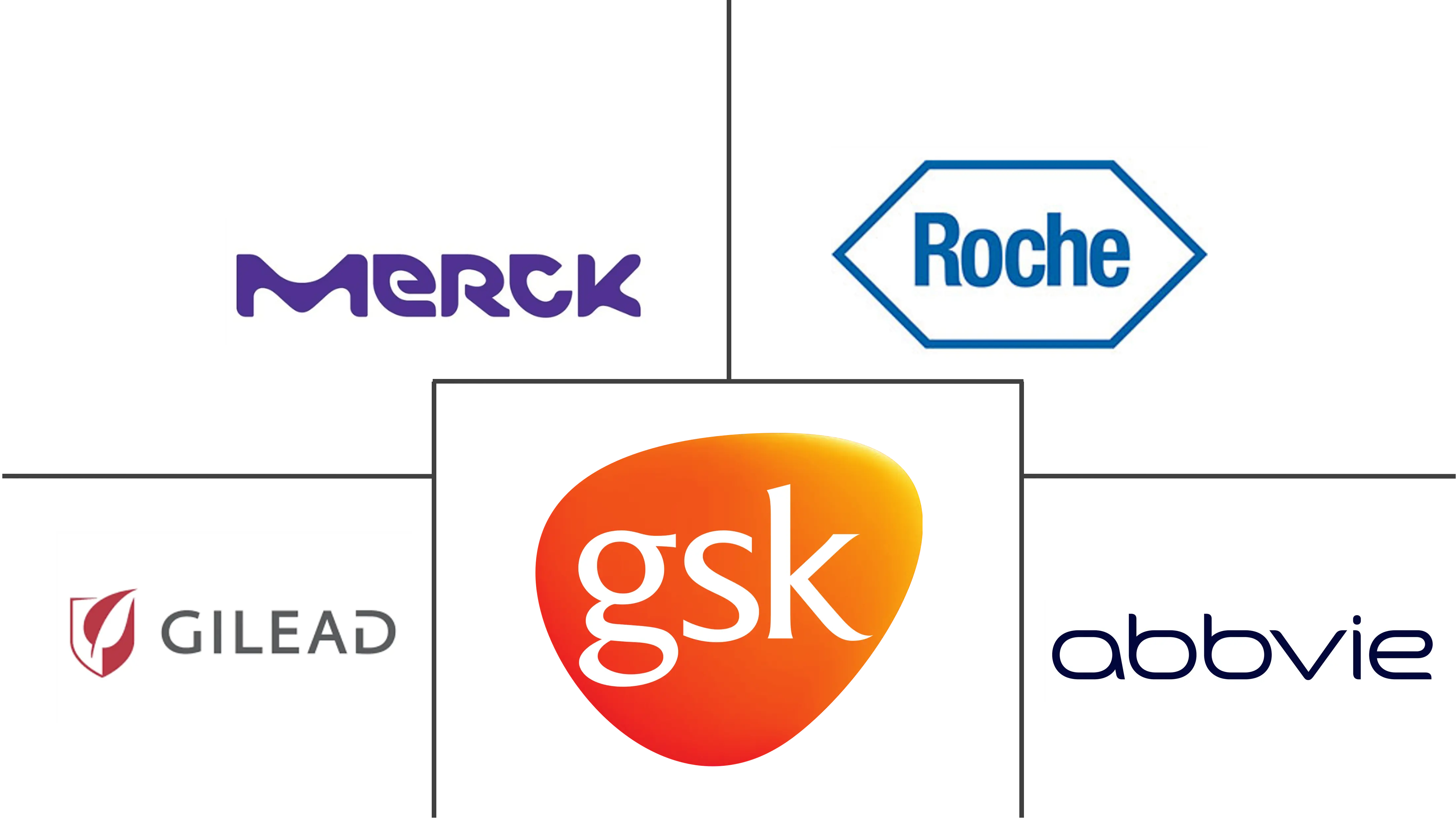Market Size of Global Infectious Disease Drugs Industry

| Study Period | 2019 - 2029 |
| Base Year For Estimation | 2023 |
| CAGR | 4.30 % |
| Fastest Growing Market | Asia Pacific |
| Largest Market | North America |
| Market Concentration | Low |
Major Players
*Disclaimer: Major Players sorted in no particular order |
Infectious Disease Drugs Market Analysis
The infectious disease drugs market is expected to register a CAGR of 4.3% during the forecast period (2022 - 2027).
The COVID-19 outbreak has had a significant impact on the market. As employment closures have curtailed import and export activities, there has been a considerable influence on the market, resulting in shortages and unavailability of infectious drugs and supplies across healthcare facilities. Due to the temporary shutdown of production facilities, export restrictions, increased demand for the COVID-19 medication, disruptions in the supply of goods, and interruptions in services, the impact of the outbreak in its initial phase on the infectious drugs market was substantial. Additionally, clinical trials of the drug have been reduced as more and more companies delay the start of most new courses in several countries. In addition, the COVID-19 epidemic has seen a decline in outpatient services for patients with infectious diseases, which has also had a significant impact on overall market growth. For instance, according to an article published by the National Center for biotechnology information, in 2021, titled " The impact of COVID-19 on hepatitis services and civil society organizations", stated that the COVID-19 pandemic has affected hepatitis prevention, testing, treatment, and vaccination services globally. Similarly, as per the data published by the World Health Organization (WHO), in 2020, most malaria-endemic countries faced moderate disruptions in anti-parasitic service delivery. However, with the resumed services and procedures and the market recovering from the COVID-19, the infectious disease drugs market is expected to regain its full potential over the forecast period.
The major factors for the growth of the infectious disease drugs market are the rising awareness activities by various government and non-profit organizations, the increasing prevalence of infectious diseases, and the rising funding and increasing research and development activities. For instance, according to the data published by the World Health Organization in the Global Tuberculosis Report 2021, most of the tuberculosis cases were found in the World Health Organization (WHO) regions of South-East Asia (43%), Africa (25%) and the Western Pacific (18%), and lesser numbers of tuberculosis cases were found in Eastern Mediterranean (8.3%), the Americas (3.0%) and Europe (2.3%). Similarly, according to the World Health Organization (WHO) data published in 2021, Sub-Saharan Africa likely continues to endure the burden of malaria, accounting for approximately 95% of all cases and 96% of all deaths. Thus, rising cases of infectious diseases are expected to increase the demand for infectious drugs resulting in the high growth of the market.
However, the low penetration rates of diagnosis and treatment in developing countries and the side effects of the drugs are likely to hinder the growth of the market.
Infectious Disease Drugs Industry Segmentation
As per the scope of this report, infectious diseases are caused by pathogenic microorganisms such as viruses, bacteria, protozoa, fungus, and parasites. The Infectious Disease Drugs Market is Segmented by Disease (HIV, Influenza, Hepatitis, Tuberculosis, Malaria, and Others), Treatment (Antibacterial, Antiviral, Antiparasitic, and Others), and Geography (North America, Europe, Asia Pacific, Middle East, and Africa, and South America). The market report also covers the estimated market sizes and trends for 17 countries across major regions globally. The report offers the value (in USD million) for the above segments.
| By Disease | |
| HIV | |
| Influenza | |
| Hepatitis | |
| Tuberculosis | |
| Malaria | |
| Other |
| By Treatment | |
| Antibacterial | |
| Antiviral | |
| Antiparasitic | |
| Other |
| Geography | ||||||||
| ||||||||
| ||||||||
| ||||||||
| ||||||||
|
Global Infectious Disease Drugs Market Size Summary
The infectious disease drugs market is poised for growth, driven by increasing awareness and prevalence of infectious diseases, alongside heightened research and development activities. The market experienced significant disruptions due to the COVID-19 pandemic, which led to shortages and unavailability of drugs, as well as delays in clinical trials. However, as services resume and the market recovers, it is expected to regain its potential. The rising incidence of diseases such as malaria and tuberculosis, particularly in developing regions, is anticipated to boost demand for infectious disease drugs. Collaborative efforts and advancements in drug development further support market expansion, with key players actively engaging in research to address these health challenges.
North America is projected to hold a significant share of the infectious disease drugs market, supported by robust healthcare infrastructure and the presence of major market players. The region's growth is fueled by the increasing prevalence of infectious diseases and a focus on developing new treatments. Companies are actively launching products and forming strategic partnerships to enhance their drug portfolios. The fragmented nature of the market, with numerous players like AbbVie Inc, Gilead Sciences, and Merck & Co., contributes to competitive dynamics. Recent product launches and collaborations, such as those by May & Baker Nigeria Plc and Bajaj Healthcare, highlight ongoing efforts to combat infectious diseases, further driving market growth.
Global Infectious Disease Drugs Market Size - Table of Contents
-
1. MARKET DYNAMICS
-
1.1 Market Overview
-
1.2 Market Drivers
-
1.2.1 Rising Awareness Activities by Various Government and Non-profit Organizations
-
1.2.2 Increasing Prevalence of Infectious Diseases
-
1.2.3 Rising Funding and Increasing Research and Development Activities
-
-
1.3 Market Restraints
-
1.3.1 Low Penetration Rates of Diagnosis and Treatment in Developing Countries
-
1.3.2 Side Effects of the Drugs
-
-
1.4 Porter's Five Forces Analysis
-
1.4.1 Threat of New Entrants
-
1.4.2 Bargaining Power of Buyers/Consumers
-
1.4.3 Bargaining Power of Suppliers
-
1.4.4 Threat of Substitute Products
-
1.4.5 Intensity of Competitive Rivalry
-
-
-
2. MARKET SEGMENTATION (Market Size by Value - USD million)
-
2.1 By Disease
-
2.1.1 HIV
-
2.1.2 Influenza
-
2.1.3 Hepatitis
-
2.1.4 Tuberculosis
-
2.1.5 Malaria
-
2.1.6 Other
-
-
2.2 By Treatment
-
2.2.1 Antibacterial
-
2.2.2 Antiviral
-
2.2.3 Antiparasitic
-
2.2.4 Other
-
-
2.3 Geography
-
2.3.1 North America
-
2.3.1.1 United States
-
2.3.1.2 Canada
-
2.3.1.3 Mexico
-
-
2.3.2 Europe
-
2.3.2.1 Germany
-
2.3.2.2 United Kingdom
-
2.3.2.3 France
-
2.3.2.4 Italy
-
2.3.2.5 Spain
-
2.3.2.6 Rest of Europe
-
-
2.3.3 Asia-Pacific
-
2.3.3.1 China
-
2.3.3.2 Japan
-
2.3.3.3 India
-
2.3.3.4 Australia
-
2.3.3.5 South Korea
-
2.3.3.6 Rest of Asia-Pacific
-
-
2.3.4 Middle-East and Africa
-
2.3.4.1 GCC
-
2.3.4.2 South Africa
-
2.3.4.3 Rest of Middle-East and Africa
-
-
2.3.5 South America
-
2.3.5.1 Brazil
-
2.3.5.2 Argentina
-
2.3.5.3 Rest of South America
-
-
-
Global Infectious Disease Drugs Market Size FAQs
What is the current Global Infectious Disease Drugs Market size?
The Global Infectious Disease Drugs Market is projected to register a CAGR of 4.30% during the forecast period (2024-2029)
Who are the key players in Global Infectious Disease Drugs Market?
AbbVie Inc, Gilead Sciences, Inc., GlaxoSmithKline plc, F Hoffmann-La Roche, Ltd and Merck & Co, Inc. are the major companies operating in the Global Infectious Disease Drugs Market.

